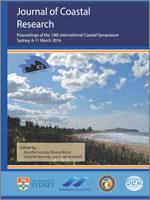Gallegos, G.; Mariño-Tapia, I., and Valle-Levinson, A., 2016. Effects of gravity waves on turbulence and processes that contribute to mixing at a submarine groundwater discharge. In: Vila-Concejo, A.; Bruce, E.; Kennedy, D.M., and McCarroll, R.J. (eds.), Proceedings of the 14th International Coastal Symposium (Sydney, Australia). Journal of Coastal Research, Special Issue, No. 75, pp. 856–860. Coconut Creek (Florida), ISSN 0749-0208.
Submarine ground water discharges (SGD) around the coasts of the Yucatán Península are very common due to the karstic origin of the rocks, and the abundant rain. These discharges of brackish water into the coastal sea are strong enough to alter the thermohaline conditions, they can be preferential routes for salt intrusion, and also represent an important input of nutrients and pollutants. The mixing on these SGDs is a spontaneous and turbulent process, and its study is important for the understanding of dispersion of materials in regions influenced by these features. A set of measurements with two acoustic Doppler velocimeters (Nortek-Vector) were done in a very active SGD in the coast of Quintana Roo, Mexico. The first instrument was installed in the entrance of the cave and the other one ∼2m above, both sampling at 64 Hz. Consistent with previous studies, results show that sea level variability (waves and tides) dominates the flow and the turbulence levels. When the spring is inactive wave frequencies (short 0.1 Hz, and 0.03 Hz long waves) have a clear peak in η and w, but when the spring is active, turbulence (Kolmogorov law) permeates to short wave frequencies, and IG frequencies diminish in η, but bulge in w at lower frequencies (0.01 Hz). Numerical modelling with Open Foam suggests that the shift in IG frequency could be driven by the spring geometry (depth and cave size) rather than forced by the incident waves.





